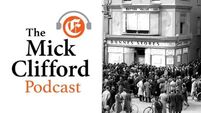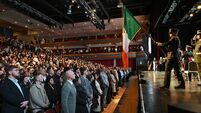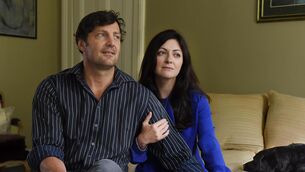America left with a lot of soul-searching to do after the election

THIS week’s presidential election has left the US with a lot of soul-searching to do — not just searching its soul, in fact, but searching for it.
After what happened at the polls, is it truer to say the soul of America lies in the rural and regional hinterlands, in largely white, Christian, conservative, blue-collar, and muddy-boot communities, cautious in their dealings with the wider world and fiercely protective of what they have created around them?
Can an argument still be made, as so often seems the case from abroad, that it dwells among the diverse, progressive, urban environments that owe their character to the flow and fusion of people from overseas and the openness of mind that it takes to accommodate their differences?
Or is it somewhere else entirely, in a people or class or mindset harder to collectively identify but possibly residing right across the street in every small town and big city in the US if only anyone had thought to walk over and knock the door to see?
Certainly, Hillary Clinton’s campaign was more readily identified with the middle group. A visit to a room it took over in the offices of the United Federation of Teachers in New York City’s financial district showed why.
As in other Democratic field offices set up in borrowed and rented rooms across the country, every inch was adorned with inspirational messages.
“Engage with purpose, organise with heart, win every day,” urged the posters on the wall.
“This person is a changemaker,” said the arrows taped to a full-length mirror catching reflections of the volunteers walking by.
Signs everywhere said: Do the most good. Stronger together. Love trumps hate. And all of the above in Spanish too.
They poured out positivity and encouraged proactivity. On election day in the office near Wall Street, volunteers were still working on a texting campaign late in the day, appealing to voters one last time to get to the polls if they hadn’t already done so.

Others sat back and chatted, sipping bottled water, barista coffees, and the odd glass of wine, while a DJ spun discs.
A man in tight pink jeans was first up on a cleared area of floor and unselfconsciously got down to Justin Timberlake and Beyoncé, pulling others up to join him.
This was a feel-good, feel-strong operation that took its tone from the uplifting Obama campaign of 2008 and, to a lesser extent, 2012.
Donald Trump’s campaign had a considerably more old-school feel to it. Its offices were functional, its messages were mean rather than meaningful, and it drew on anger as an energy and blame as a motivation.
But does the fact that it worked mean it captured a mood or created it? Did it tap into an already full vein of discontent or did it dig and dig until it found a reserve it could pump to the surface?
There were no Beyoncé booty dances at the Republican Club office in Guernsey County, Ohio.
A volunteer politely shook hands, made his excuses and left, saying he’d be back before long.
He returned with a bottle of black raspberry wine, homemade from the fruits growing wild in the surrounding Appalachian countryside. With quiet pride he placed it carefully on the floor where it wouldn’t get knocked and wished good enjoyment of it.
“We’re cordial people,” said the club president after the volunteer had left. It had not been suggested otherwise but he’d seen the footage from the Trump rallies where garish supporters in shirts bearing offensive messages spoke a little too loudly and crudely for comfort.
They were cordial — quick to offer a lift, an introduction, information, or whatever else might be of assistance to a person passing through town.
Their views were no less rigid than those of the rally groupies, but less stridently expressed.

If the rallies seemed like a travelling circus attended by clowns — easy to dismiss as likely to be of little substance at the polls — these nice-as-pie berry-wine makers were the true backbone of the support for Trump.
But are these more reflective of the true spirit of America, and if so, how swiftly would their hospitality be tested if the stranger was, say, black or Muslim?
They would reject any accusation of racism, such as that which ran through Trump’s diatribes, because to their minds, he was trying to root out bad guys and skin colour was incidental.
There weren’t too many people of colour in these communities to gauge the wider impact of Trump’s words.
A Somali had been arrested somewhere in the country, it was explained, for performing female genital mutilation. Proof, it was suggested, that “these people” could not be allowed into the US.
The story, told from a different perspective, could have emphasised the fact that this person was successfully apprehended, that the law of the US did not tolerate the behaviour, that one transgressor flouting the law did not weaken it, and that the country remained robust in its opposition to such practices.
Instead, it focused on one person and escalated their wrongdoing into the need for a the national blockade. The mental blockade was already there.
And yet the elections that took place alongside the presidential ballot for places in Congress and the House of Representatives returned extra, though still small, numbers of people of colour.
So how much does racism taint the soul of America? For that matter, how much does misogyny?

Throughout the campaign, Hillary Clinton was repeatedly condemned for standing by her husband through his sexual infidelities.
Trump’s own infidelities and sexual misconduct was just him being a man. All the more manly because of it, seemed to be the interpretation by many.
Clinton was criticised for being a career politician and having the ambition to climb her way to the top over three decades in public service.
Trump’s arrogance in presuming to deserve the most powerful position in the country just because he wanted it and had the money to buy it, was him living up to the art of the deal and proving fantasies can become real, all the more admirable because of it.
When Trump said Clinton didn’t look presidential, folk studied the lines on her face, the fullness of her figure, and the functionality of her pantsuits, and turned back to idolising Kim Kardashian.
When Trump appeared orange-faced, overweight, hair resembling the bed of hay in a Christmas crib, pale lips pursed, and eyes narrowed so tight their colour can not be seen, they thought how great it was that an ordinary looking guy should get such a hot wife. Three of them, in fact.
Hillary couldn’t get away from the gender issue. When she tried to campaign on women’s rights — equality rights, really — she was condemned for playing the women’s card.
She tried to embrace the criticisms, repeatedly using the slogan, ‘If striving for equality means playing the women’s card, deal me in’.
It did little good in a country where, it appears, many don’t believe a woman should even be at the card table.
Or is it unfair to categorise the America that spoke last Tuesday in any of the above ways?
Was it simply a case that a sufficient number of people felt tired enough from the struggles of the recession, angry enough to want to blame the rest of the world, and desperate enough to put their faith in whoever sold them the biggest dream and the simplest solutions? Did we just get America on a bad day?

There are usually safeguards in the law and institutions to help prevent the soul of any country sinking into dark terrority and the US has long relied on those that support the mantra, ‘land of the free and home of the brave’.
But these two key tenets of belief in the American way need scrutiny now. In a land of the free, freedom of speech has always been cherished as a right that enables all to have a voice, to speak with honesty, and to share ideas so that no one in power goes unchallenged and no one in the masses need feel forgotten.
Somehow that treasured ideal has been hijacked and turned into a right to spite, to spit out insults, to lie and distort, to spread fear and drown out reasonable debate with deafening propaganda.
What about that other bulwark against the shrinking soul — democracy itself? The home of the brave is built upon it and every schoolchild grows up to believe theirs is the greatest in the world because anyone with the courage of their convictions can become president. Anyone including, as we now know, a man who brought buffoonery and belligerence to his audition for the job and who many fear will repeat the performance in power.
The Organisation for Security and Co-operation in Europe (OSCE) sent 300 election monitors from 43 countries to polling stations around the US on Tuesday to observe the ballot and watch out for evidence of the rigging Trump insisted would happen and the intimidation Clinton’s camp feared.
A day later, they provided their preliminary report and gave the process, for the most part, a clean bill of health.
Americans in high numbers took the opportunity to freely choose their leadership, they said, but there were many sharp criticisms.
The campaign was “characterised by harsh personal attacks, as well as intolerant rhetoric, particularly by one candidate”, the report states.
“There was frequent use by one presidential candidate of intolerant discourse aimed at women, minorities, and people with disabilities.”
The electoral system was really 50 separate elections, they said, a fundamental weakness with a lack of countrywide standards leading to myriad regulations regarding the candidate and voter-registration process, the requirements for voter identification, and the machinery used in voting.
There was criticism of the two-party system in which the US effectively boxes all voters, with third party and independent candidates facing obstacles registering their candidacy in all states.

Provisions of the Voting Rights Act struck down by Republicans two years ago meant less federal government involvement in how presidential elections were run — southern states used this to move and close polling stations in mainly minority communities and change voter- registration rules.
The changes resulted in “removing a timely and effective safeguard for the protection of rights for racial and linguistic minorities”, states the OSCE. “Technical aspects of the process were often motivated by partisan interests.”
Contrary to good practice, 15 states had no paper trail to back up their electronic voting, making recounts impossible.
Efforts at voter engagement were criticised, with an estimated 35m people not registered to vote; it was noted that 6m convicts, including those with sentences served, were also excluded. “Suffrage rights are not guaranteed,” says the report.
Instances of long queues and malfunctioning voting equipment didn’t help matters.
Time and again, the report emphasises the exclusion — or vulnerability to exclusion — of minority and marginalised communities.
They didn’t even get started on the bizarre and archaic college electoral vote system that determines who becomes president. In the great democracy of the US, the ‘one man, one vote’ principle does not apply, not all votes are equal, and a candidate can win the most votes overall to be the popular choice of the people and still have to concede to their rival.
The protests that took place across seven US cities the evening after Donald Trump’s election ran chiefly on the message “not my president”.
They could, with some justification, equally have used the slogan “not my democracy” because it is not the fair, free, and noble one that has been sold to Americans as their right for generations.
Wherever the soul of the US lies after this week’s election, and whatever its characteristics are, it looks like it is set for more than a little torment in the four years that lie ahead.
















